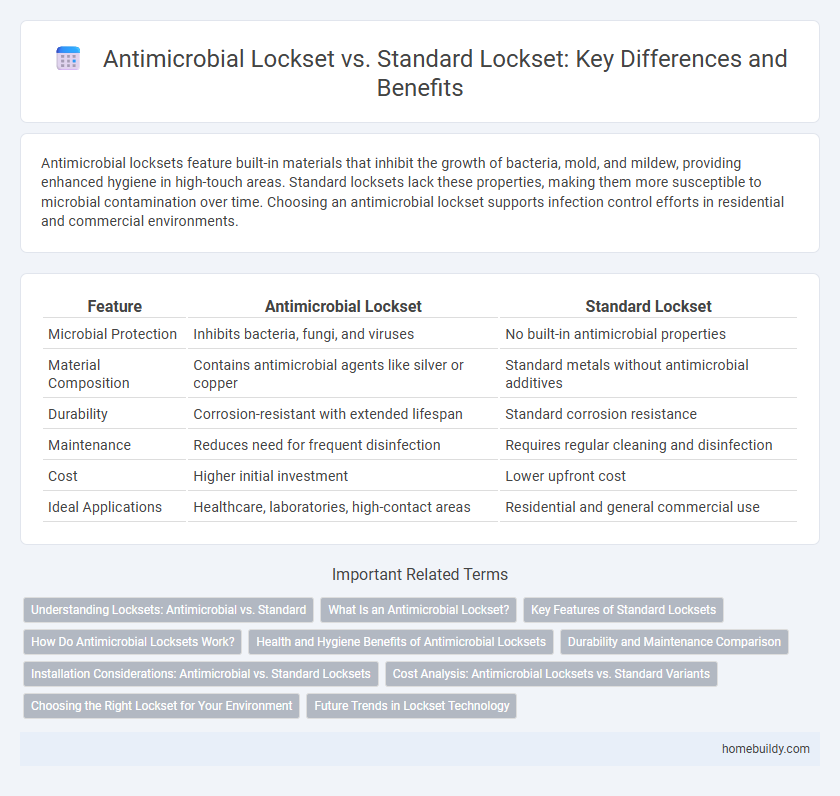Antimicrobial locksets feature built-in materials that inhibit the growth of bacteria, mold, and mildew, providing enhanced hygiene in high-touch areas. Standard locksets lack these properties, making them more susceptible to microbial contamination over time. Choosing an antimicrobial lockset supports infection control efforts in residential and commercial environments.
Table of Comparison
| Feature | Antimicrobial Lockset | Standard Lockset |
|---|---|---|
| Microbial Protection | Inhibits bacteria, fungi, and viruses | No built-in antimicrobial properties |
| Material Composition | Contains antimicrobial agents like silver or copper | Standard metals without antimicrobial additives |
| Durability | Corrosion-resistant with extended lifespan | Standard corrosion resistance |
| Maintenance | Reduces need for frequent disinfection | Requires regular cleaning and disinfection |
| Cost | Higher initial investment | Lower upfront cost |
| Ideal Applications | Healthcare, laboratories, high-contact areas | Residential and general commercial use |
Understanding Locksets: Antimicrobial vs. Standard
Antimicrobial locksets feature a specialized coating or material designed to inhibit the growth of bacteria, fungi, and viruses on frequently touched surfaces, reducing the risk of cross-contamination in high-traffic environments. Standard locksets lack these protective features, making them more susceptible to harboring harmful microorganisms, which can contribute to the spread of infections. Choosing antimicrobial locksets enhances hygiene standards in healthcare facilities, schools, and public buildings by providing an extra layer of microbial protection.
What Is an Antimicrobial Lockset?
An antimicrobial lockset incorporates materials treated with antimicrobial agents designed to inhibit the growth of bacteria, mold, and mildew on its surfaces. Unlike standard locksets, these specialized coatings or metals, such as copper or silver ions, actively reduce microbial contamination, promoting a cleaner and more hygienic environment. Antimicrobial locksets are particularly beneficial in healthcare, food service, and high-traffic public areas where reducing pathogen transmission is critical.
Key Features of Standard Locksets
Standard locksets offer reliable security through mechanical components such as sturdy deadbolts and latch mechanisms, designed for durability and ease of use. They typically feature metal construction with finishes like brass or stainless steel, providing resistance to wear and corrosion in everyday environments. These locksets support various keying options including keyed entry, privacy, and passage functions, making them versatile for residential and commercial applications.
How Do Antimicrobial Locksets Work?
Antimicrobial locksets incorporate materials such as copper, silver ions, or specialized coatings that inhibit the growth of bacteria and microbes on their surfaces. These locksets utilize biocidal agents that disrupt microbial cell membranes or interfere with essential cellular processes, reducing the risk of contamination. Unlike standard locksets, antimicrobial locksets maintain a cleaner, safer surface by continuously preventing microbial proliferation.
Health and Hygiene Benefits of Antimicrobial Locksets
Antimicrobial locksets significantly reduce the presence of harmful bacteria and viruses on frequently touched surfaces, lowering the risk of cross-contamination in healthcare and public environments. These locksets incorporate materials with proven antimicrobial properties, which inhibit microbial growth and enhance overall hygiene. Their use promotes safer, cleaner spaces, ultimately supporting infection control protocols and public health safety measures.
Durability and Maintenance Comparison
Antimicrobial locksets feature coatings that inhibit bacterial growth, enhancing durability by reducing corrosion and wear compared to standard locksets. These locksets require less frequent maintenance as their surfaces resist microbial buildup and grime, extending service life. Standard locksets often demand more regular cleaning and replacement due to susceptibility to rust and contamination, impacting long-term reliability.
Installation Considerations: Antimicrobial vs. Standard Locksets
Antimicrobial locksets require similar installation procedures as standard locksets but may include additional steps to preserve the integrity of their antimicrobial coatings during handling. Installation should avoid abrasive tools that could damage surface treatments, ensuring the antimicrobial properties remain effective over time. Standard locksets allow straightforward installation without special considerations for surface integrity, making them quicker but lacking ongoing microbial resistance benefits.
Cost Analysis: Antimicrobial Locksets vs. Standard Variants
Antimicrobial locksets typically incur higher initial costs compared to standard locksets due to advanced materials and coating technologies designed to inhibit microbial growth. Over time, antimicrobial locksets may offer cost savings by reducing maintenance frequency, lowering infection-related liabilities, and enhancing overall hygiene in healthcare and high-touch environments. A comprehensive cost analysis should account for initial purchase price, lifecycle savings, and potential indirect benefits like improved health and reduced contamination risks.
Choosing the Right Lockset for Your Environment
Antimicrobial locksets feature coatings embedded with silver ions or copper compounds that inhibit bacterial growth, making them ideal for healthcare, food processing, and high-traffic public areas. Standard locksets lack these protective properties but often offer greater variety in styles and finishes for residential or low-risk commercial spaces. Selecting the right lockset depends on balancing hygiene requirements with aesthetic preferences and durability needs in your specific environment.
Future Trends in Lockset Technology
Antimicrobial locksets are increasingly integrated with advanced materials like copper and silver ions that inhibit bacterial growth, setting a new benchmark in hygiene standards for security hardware. Future trends suggest a rise in smart lock systems combining antimicrobial properties with IoT connectivity, enabling real-time monitoring and remote access control. Enhanced durability, energy efficiency, and seamless integration with building management systems are key development areas driving innovation in lockset technology.
Antimicrobial Lockset vs Standard Lockset Infographic

 homebuildy.com
homebuildy.com